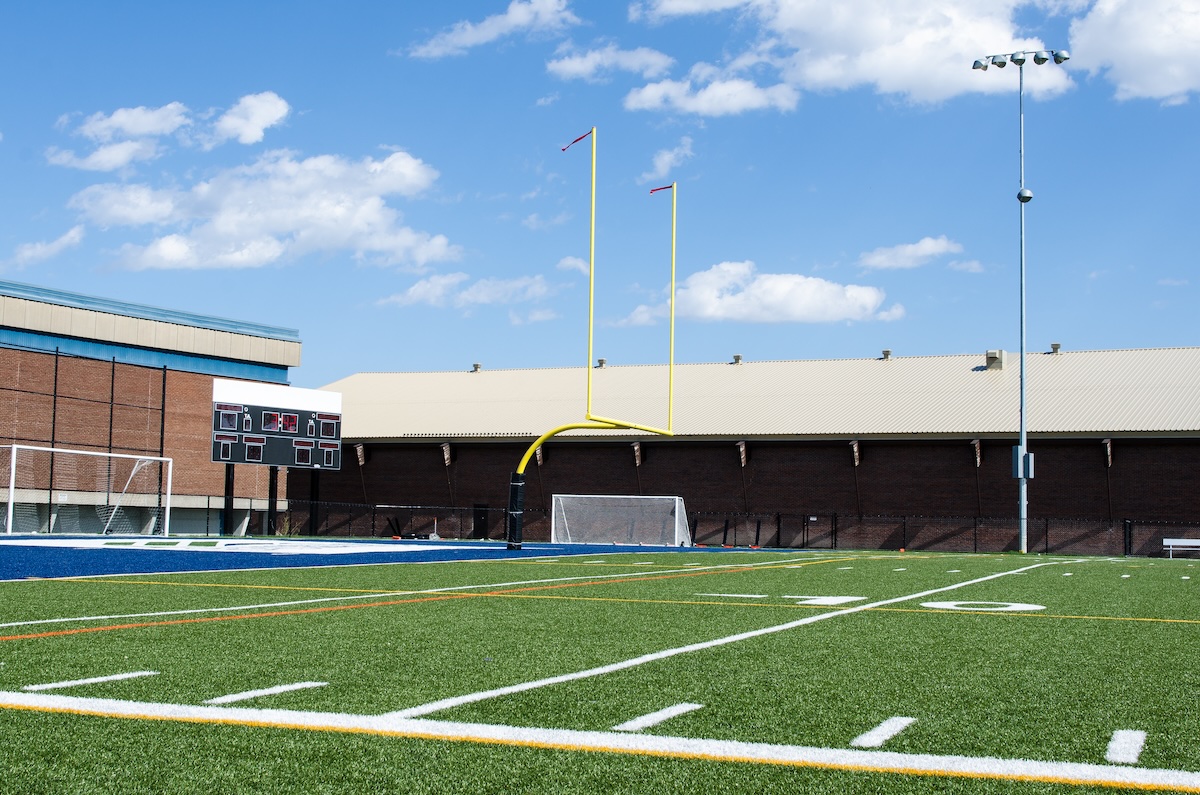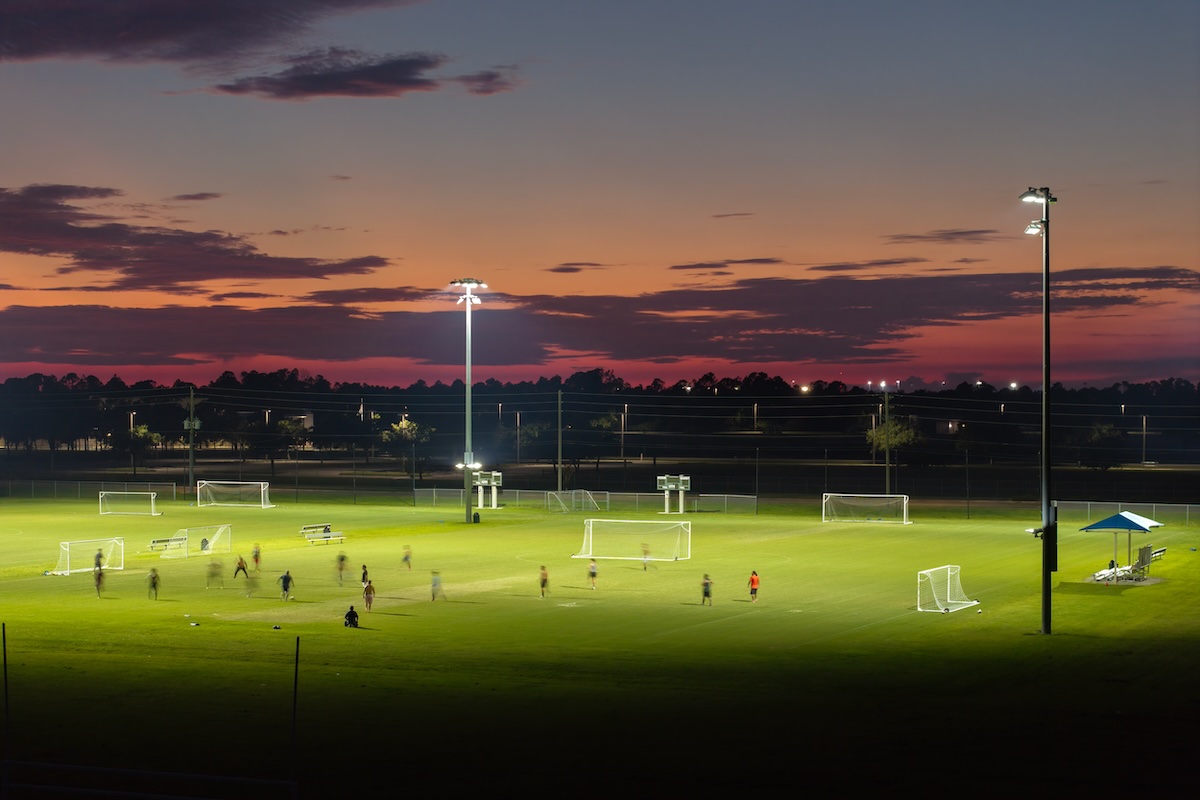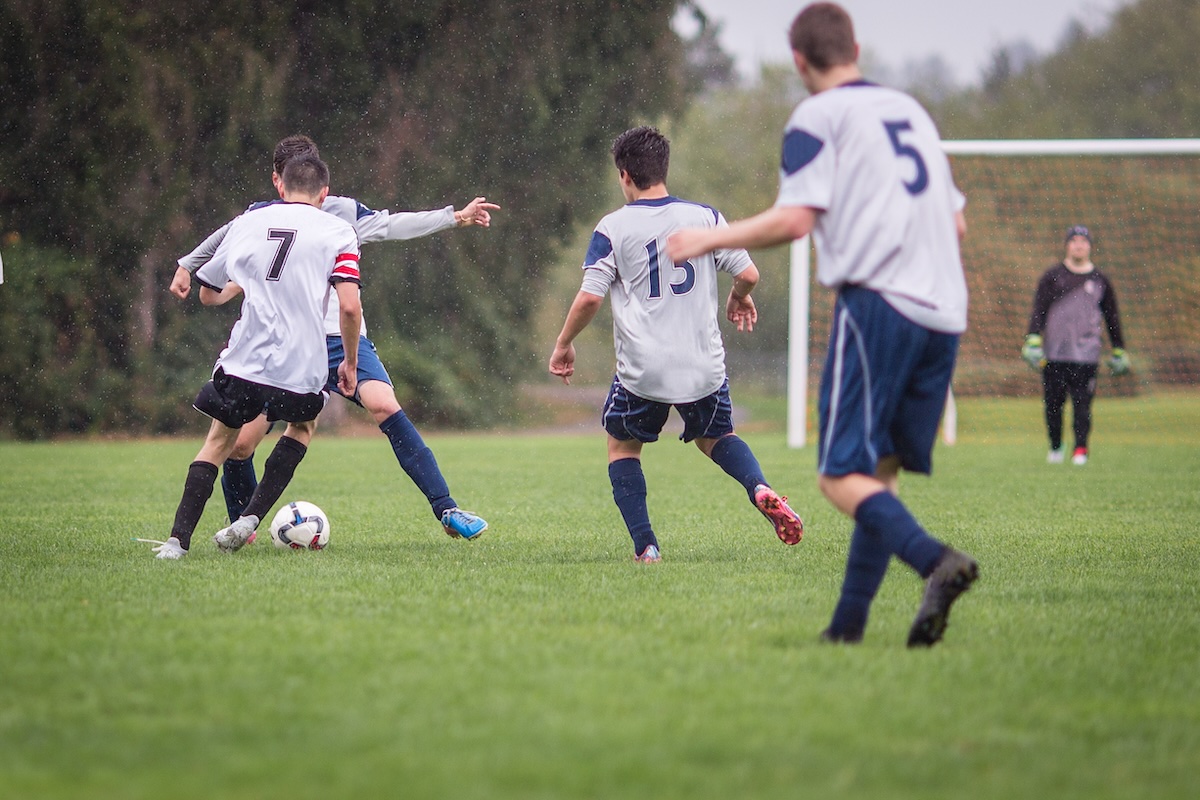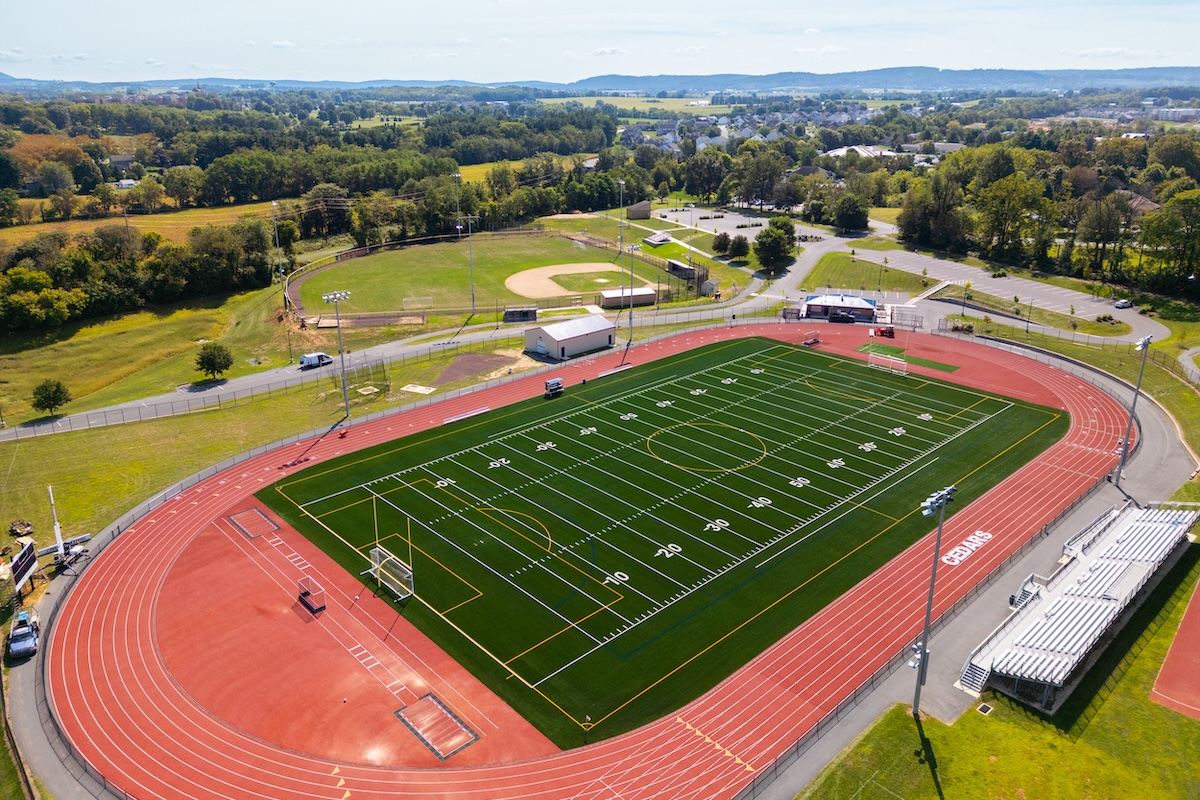Last Updated on September 30, 2025 by UDC Sports
Every school has a field. Maybe it’s where PE classes stretch in the mornings, or where the football team runs drills in the late afternoon. The grass wears thin in the same spots each season, and the scoreboard might be something borrowed from a generation ago. For a while, it works. But there eventually comes a point where the field feels too small—where the community has outgrown a patch of grass and is ready for something that feels more like a stadium.
Now of course, that shift usually isn’t meant to chase the scale of a professional arena or an NFL stadium. For most schools, it means creating a field or a modest, scaled-down school stadium that feels worthy of the students playing on it and the families filling the bleachers. It’s about Friday nights under the lights, when the marching band takes the field, and the sound of the crowd feels bigger than the town itself.
What Counts as a “Small School Stadium”?
The term isn’t exact—it generally refers to school facilities that go beyond a basic field, but aren’t anywhere near the scale of college or pro arenas. In the world of sports field construction firms, a small school stadium might only include bleachers for a few hundred fans, field lighting, and essentials like fencing and a scoreboard. These spaces are designed to serve students and their community, not necessarily tens of thousands of spectators, and often grow in phases as budgets allow.
Building the Foundation Right
Before anyone thinks about bleachers, lights, or scoreboards, the real foundation of a school’s athletic program is the field itself. For most people, it may not seem like the most interesting part of the project. However, everything else depends on getting this part right. A beautiful press box doesn’t matter much if the field beneath it turns into mud after the first heavy rain.

One of the first big decisions most schools face is the surface—natural grass or synthetic turf. Both have strong cases. Grass has tradition behind it. It’s familiar, it feels good underfoot, and for schools that don’t pack their calendar with back-to-back practices and games, it can be managed effectively with the right care.

But artificial turf, comparatively, earns its reputation as a workhorse. When one field needs to serve as the practice space in the morning, host PE classes in the afternoon, and then carry a full varsity game under the lights at night, synthetic turf can absorb that constant use in a way grass usually can’t.
Turf vs. Grass
Modern artificial turf can handle a packed schedule of practices, PE classes, and games without the constant re-seeding.
Grass, while generally more expensive and time-consuming to maintain, carries a tradition and feel that many schools still value.
But whichever route a school takes, the conversation can’t stop at “grass or turf.” Drainage and grading are what separate a field that looks good on opening day from one that holds up season after season. A perfectly laid synthetic turf system can still feel like a mistake if water pools across the surface or if a cold snap freezes a poorly designed base. Now, the same goes for natural grass, of course—without proper grading and subsurface drainage, the most carefully maintained sod will quickly turn into a patchwork of ruts and puddles.
This is where small details can make a really big difference. The slope of a field, the way water is directed off the sidelines, the layers of stone or gravel beneath the surface—none of it is too visible once the field is finished, but all of it determines how playable that field is in the long run.

Schools that invest here may see the payback in the form of fewer cancellations, less maintenance frustration, and a better overall experience for their students.
And for those campuses that plan to grow from a simple field into a small stadium over time, getting this groundwork right is even more important. Bleachers and lights can be added later, but redoing the base of a field once the infrastructure is in place is both costly and disruptive. Laying a strong foundation now means the school can expand confidently later, knowing the field underneath will support whatever comes next—whether it’s a modest set of stands or a full stadium atmosphere for Friday night football.
Drainage & Grading
Whichever direction a school chooses, drainage and grading matter just as much as the surface. A soggy end zone or a worn-out midfield can take the shine off an otherwise exciting season, no matter how new the turf or grass may be.
Planning for More Than One Team
Schools don’t always have the space—or the budget—for separate fields devoted to each sport. That means the main field has to be a jack of all trades, carrying the weight of football on Friday nights, soccer matches on fall afternoons, and lacrosse games or track meets in the spring. On top of that, it often doubles as the marching band’s rehearsal stage and the PE department’s go-to space for classes. When you add it all up, a single sports field can end up being one of the busiest facilities on campus.
Now, planning for that kind of overlap takes more than just painting a few extra lines. It’s going to require some serious forethought about how dimensions, layouts, and equipment will interact over the years. (This is where an experienced sports field construction contractor can be extremely helpful.)
For example, soccer and football fields share turf, but the goals and end zones don’t line up perfectly. Without planning, you can end up with awkward sightlines or confusing striping that frustrates both athletes and coaches. The same goes for lacrosse: its boundary lines and crease markings need to be considered from the start, not tacked on after the fact.
In smaller stadiums and multi-sport facilities like those constructed at schools, these design decisions are magnified. Coaches, athletic directors, and band directors all end up sharing the same space, which means the field has to serve a lot of different groups—all without showing wear too quickly. To make sense of it, it helps to look at some of the major sports and activities that typically land on a school field in America, and what each one demands from a design and maintenance standpoint:
| Sport | Field Dimensions / Markings | Key School Considerations |
|---|---|---|
| Football | 120 yds long (including end zones), 53⅓ yds wide | Requires durable turf/grass to withstand heavy use and high-impact play. Lines, numbers, and hash marks must be clear. Lighting and scoreboard visibility are especially important for night games. |
| Soccer | 100–120 yds long, 55–80 yds wide | Often shares space with football fields; multipurpose striping is common. Requires even sports field surface installation and consistent turf height for safety. Goals need secure anchoring and safe storage when not in use. |
| Lacrosse | 110 yds long, 60 yds wide | Lines overlap with soccer and football; clear markings are critical. Crease areas need precise layout. High wear near goal areas—turf reinforcement helps reduce maintenance. |
| Baseball / Softball | Varies (90 ft bases for baseball, 60 ft for softball) | Requires separate diamond with infield mix, pitcher’s mound, and outfield turf. Drainage around the infield is crucial to prevent washouts. Protective fencing and backstops are standard safety features. |
| Track & Field | 400m oval standard; surrounds a multipurpose field | Requires durable surfacing material and accurate lane striping. Field events (long jump, pole vault, shot put) need dedicated spaces. Careful integration with football/soccer fields in the center is common. |
| Field Hockey | 100 yds long, 60 yds wide | Requires smooth, even playing surface—turf is strongly preferred. Can share with soccer or lacrosse but needs distinct markings. Demands attention to safety in high-traffic goal areas. |
The Pieces That Make It Feel Like a Stadium

Once the field itself is settled, attention naturally turns to the details that shape how the space feels for players, students, and families. These aren’t always structural must-haves like drainage or turf systems, but they’re the elements that take a plain field and turn it into something that feels complete.
Bleachers are a good example. Many schools start out with a few sets of aluminum stands, portable or tucked along the sideline. They get the job done, but they often feel temporary. Upgrading to seating that’s integrated into the sports field design—not oversized, just thoughtfully placed and safe—makes a big difference. Parents and grandparents notice when they can sit comfortably, when there are railings to hold onto—and when they don’t feel like they’re climbing scaffolding just to watch a game.
Lighting works the same way. A field without lights can only be used so many hours a day, and scheduling gets tight when practices, PE classes, and evening games all compete for time. Adding modern, efficient LED lighting doesn’t just extend the schedule—it creates a real sense of occasion.
Friday night football under the lights feels different from an afternoon scrimmage, and soccer matches in the evening become events the whole school can rally around. Even small school stadiums can capture that energy without breaking the budget by planning for lights early, even if installation comes in a later phase.
Scoreboards
Students and fans want to follow the game in real time, and coaches depend on accurate, visible clocks.
A scoreboard that everyone can see clearly—paired with a sound system that carries across the field without distortion—elevates the experience from a practice-field scrimmage to a true competition.
And then there are the important details that aren’t always considered before an experienced sports field construction company or contractor is contacted: ADA-compliant walkways that make it easy for families with strollers or older fans with mobility challenges to reach their seats; protective netting that keeps foul balls or stray kicks from disrupting the crowd; fencing that channels traffic and keeps the playing surface safe.
Even modest school stadiums benefit from a press box—whether it’s a simple structure for announcers and media or a slightly larger space that doubles as storage and controls for the scoreboard and lights. It doesn’t need to rival a pro venue’s tower, but it does provide a vantage point and infrastructure that help run events smoothly.
Phasing Growth Without Losing Sight of the Vision

Most schools can’t build everything in one go—and that’s okay. Budgets are real, resources are limited, and priorities shift from year to year. The key is making sure the pieces you build now fit seamlessly with what you hope to add later.
It almost always starts with the essentials: the field itself and a way for people to watch the game. Once that foundation is solid—turf or grass laid correctly, drainage systems working, safe seating in place—the school has something usable right away. From there, growth can happen in stages. Lights may come next, opening up the possibility of evening games and easing scheduling pressure when multiple teams share the same field. Restrooms, concessions, and storage follow, each one making the space a little more functional, a little more welcoming.
Plan for the Long Term
It’s important to avoid treating these steps as isolated fixes. A scoreboard placed without considering future bleachers, or fencing that blocks where restrooms might go, forces expensive changes later. When a long-term plan guides short-term choices, every addition feels intentional and integrated, not like a patchwork.
Schools that approach it this way may find they can stretch their investment further. Maybe the first year only brings a modest set of bleachers and a natural grass field, but if the grading and layout are done correctly, those bleachers can later tie into larger seating, and that grass can be upgraded to turf without starting over. Even a small press box can be designed so it expands in the future rather than being torn down and rebuilt.
This phased approach also keeps the community involved. Each new addition becomes a milestone to celebrate—lights going up, the first game played under them, a new scoreboard unveiled, or the ribbon-cutting on restrooms that finally make long nights more comfortable for families. Instead of waiting years for a perfect stadium to materialize, the school grows its facility step by step, and people get to see their support and investment pay off in visible ways.
In the end, the goal isn’t to rush to the finish line. It’s to create a field or stadium that feels cohesive and built to last, no matter how many phases it takes to get there. A smaller start, done thoughtfully, sets the stage for growth that matches the pace of the school and the community it serves.
Final Thoughts

When people talk about building a field or a small stadium, it’s easy to focus on the technical side—the turf system, the drainage layers, the bleachers, the lights. Those are all critical pieces, but the real measure of success is what the space means once the games begin. A well-built field becomes more than an athletic facility. It becomes a stage for memories.
Think about a Friday night where the band is warming up under the lights, the crowd is filing in, and the first kickoff hasn’t even happened yet but there’s already a sense of energy in the air. Or picture a Saturday morning youth soccer tournament, with families setting up chairs along the sidelines, little kids running around with juice boxes, and the field serving as the anchor for an entire day of community activity. These are the moments that give the investment value beyond just the scoreboard.
Schools also use these spaces for more than sports. Graduation ceremonies, pep rallies, even community events like holiday parades or local fundraisers often spill onto the same ground where athletes compete. That versatility is part of what makes a school field or stadium so central—it’s one of the few places where just about everyone in the community has a reason to gather together, whether they’re an athlete, a parent, a teacher, or a neighbor.

For students, the impact is even more personal. A home field that feels cared for tells them their efforts matter, whether they’re running sprints at practice or standing with their teammates before a big game. For their families, it’s about accessibility and pride—being able to watch their children play or perform in a setting that feels safe, comfortable, and worthy of the occasion. And for alumni, a stadium often becomes a place to return to, a reminder of their own time on the field and the traditions that continue after them.
That’s why schools put so much thought into these projects. A field is never just a patch of turf or grass. A small stadium is never just a set of bleachers and lights. When built thoughtfully, your newly-constructed academic sports venue can become a touchstone of the community—a place where moments stack up year after year until they’re woven into the story of the school itself.


